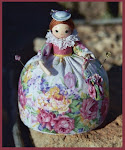Carolyn taught me how to make long felted beads (which can be cut into shorter beads). The tools are simple: four wooden pencils (the kind that have six sides), rubber bands, a rattan place mat, hot soapy water (Ivory dish soap), and merino wool roving. This long bead was embellished with shiny threads and seed beads, then strung onto a necklace made of twisted yarn cording. Easy. (You can make all the photos larger by right clicking on the photo and opening it in a new window.)
Please note: Carolyn checked my instructions, and here are her notes on the process, involving the temperature of the water. Although I like to use very hot water (as in my instructions) it is important, when working with children, that the water should not be extra hot. "Hi there, good directions and pics! I only have one thing to add -- you really do not need to use very hot water. I start with hot water (not too hot for your hands) and put it in bowls on the tables when I teach this, and the water gets pretty luke-warm and then cold, and still works. It's probably better to replace it with more hot, but it really doesn't need to be very hot."
For this bead, below, I chose rovings in colors to match some beads & fibers I had on hand.
A white (filler) roving was used first. Spread it thin and wind it around the four pencils, which are held together at each end with rubber bands. (Please note: I am holding down the roving with the container of spoons to show how to stretch it out thinly. I had the camera in my other hand! You don't need to use any weighted objects in this project. I almost dropped my camera in the sink at one point!)
Wind the roving back & forth, from side to side a couple times.
Until it is about this thick:
Next the main color of roving is used.
Wind it back & forth, from side to side, a couple times. Keep the roving off the rubber bands! If you don't, you won't be able to get those pencils out later. (If you want to make a shorter bead, bring the rubber bands in.
Contrasting, thin pieces of roving are wound around for decoration.
Back & forth, from side to side, but always winding in the same direction. (I go over the top and behind.)
Get your water quite hot (as hot as you can comfortably stand; rubber gloves are a must for children - or simply make it extra warm as per Carolyn above). It should also be really soapy.
Dip in the hot, soapy water, and squeeze out the water, several times. Roll lightly on mat in forward direction only. (If you roll up and down at this point, the fibers will want to unwind off the roll.)
Please understand that your finished bead will not look exactly like the contrasting fibers you laid down so carefully. That's the fun part of felt bead making! Roll it lightly to keep the fibers intact as much as possible.
Re-dip in the hot, soapy water (add drops of soap directly on the bead if necessary) and squeeze out the soapy water. Lightly roll. Do this several times, checking it, re-dipping, squeezing, and rolling lightly on top of the mat.
When you can see that it is starting to felt, you can roll harder, on top of or inside the rattan place mat, back and forth, roll roll roll!
When it starts to really felt and shrink, take the rubber bands off and remove one of the pencils.
Re-dip, add drops of soap directly if necessary, squeeze out excess.
Roll hard, re-dip, squeeze, roll some more. Repeat. Take out another pencil, re-dip, squeeze, roll hard!
Repeat this process of re-dipping, squeezing, and rolling hard, until you are down to one pencil and the felted roving is very tight around the last pencil. See how soapy my hand is? Lot's of soap was used!
Here is the bead on the last pencil. When fully felted, rinse it very well in hot water, to get all the soap out.
Remove excess water with towel.
Remove pencil, and thread yarn through the bead with a bodkin.
Tie bead around a mason jar or other round object that suits the shape you want your bead to take.
Put in sunny spot to dry thoroughly.
A few days later I made more beads. This time after the fourth pencil was removed, I inserted plastic tubing from the hardware store, a little smaller than the pencil diameter. I continued to felt it and let the felt dry over the tubing. I then cut the long bead into four shorter beads. The plastic tubing gives the beads a firmness, and your yarn can be threaded through the tubing. (See picture above, under Fiber Camp post)
NEXT -- a Felted Headband and Round Beads


+roving+first;+spread+thin+RESIZED.jpg)


































;+roll+it+VERY+GENTLY++between+your+palms+RESIZED.jpg)





















